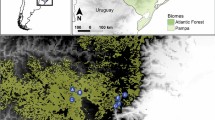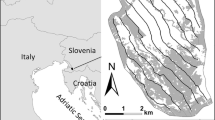Abstract
Prescribed burning is routinely used to improve grazing in Pyrenean rangelands affected by an overall trend of land abandonment. This study considers the environmental variables influencing habitat occupancy by birds and the consequences of the use of fire in range management for bird conservation. Bird use and habitat structure of 11 cover types, the result of specific management regimes, were monitored for two breeding seasons in a mosaic landscape. Three main gradients of avian composition, corresponding to tree cover, shrub volume and grazing intensity, were identified from canonical correspondence analysis. The structure of the bird community seemed more intensely affected by species-specific selection of cover types than by the birds' use of multiple patches. Out of a total of 10 bird species analysed by a simultaneous confidence intervals procedure, four species with an unfavourable conservation status in Europe (Emberiza cia, Lullula arborea, Saxicola torquata and Lanius collurio) preferred managed grassland. Three types of grassland with shrubs (derived from single or repeated burning) had the highest bird conservation index (taking into account specific status and abundance of the bird assemblage), whereas forests showed middle or low values. The relation (P = 0.054) of this index to the logarithm of the pastoral value (which includes density and grazing quality of grasses) in currently managed cover types suggests that the objectives of grassland recovery by appropriate management practices and those of bird conservation coincide in our study area.
Similar content being viewed by others
References
Alldredge A.W., Thomas D.L. and McDonald L.L. 1998. Survey and comparison of methods for study of resource selection. Journal of Agricultural, Biological, and Environmental Statistics 3: 237–253.
Bailey B.J.R. 1980. Large sample simultaneous confidence intervals for the multinomial probabilities based on transformation of the cell frequencies. Technometrics 22: 583–589.
Baines D. 1996. The implications of grazing and predator management on the habitats and breeding success of black grouse Tetrao tetrix. Journal of Applied Ecology 33: 54–62.
Barbero M., Bonin G., Loisel R. and Quezél P. 1990. Changes and disturbances of forest ecosystems caused by human activities in the western part of the Mediterranean basin. Vegetatio 87: 151–173.
Blondel J. and Farré H. 1988. The convergent trajectories of bird communities along ecological successions in European forests. Oecologia 75: 83–93.
Bibby C.J. and Buckland S.T. 1987. Bias of bird census results due to detectability varying with habitat. Acta Oecologica 8: 103–112.
Carrascal L.M. 1983. Análisis comparativo de cinco sistemas de muestreo del uso del espacio en aves forestales. Ardeola 30: 45–55.
Cherry S. 1996. A comparison of confidence intervals methods for habitat use-availability studies. Journal of Wildlife Management 60: 653–658.
Daget P. and Poissonet J. 1971. Une methode d'analyse phytologique des prairies. Critères d'application. Annales Agronomiques 22: 5–41.
Debussche M., Lepart J. and Dervieux A. 1999. Mediterranean landscape changes: evidence from old postcards. Global Ecology and Biogeography 8: 3–15.
Díaz M., Carbonell R., Santos T. and Tellería J.L. 1998. Breeding bird communities in pine plantations of the Spanish plateaux: biogeography, landscape and vegetation effects. Journal of Applied Ecology 35: 562–574.
Donald P.F., Green R.E. and Heath M.F. 2001. Agricultural intensification and the collapse of Europe's farmland bird populations. Proceedings of the Royal Society, London B 268: 25–29.
Etienne M., Derzko M. and Rigolot E. 1996. Browse impact in silvopastoral systems participating in fire prevention in the French Mediterranean region. In: Etienne M. (ed.), Western European Silvopastoral Systems, ‘science update’ series. INRA, Paris, pp. 93–102.
Everitt B.S. 1977. The Analysis of Contingency Tables. Chapman &; Hall, London.
Flather C.H. 1996. Fitting species-accumulation functions and assessing regional land use impacts on avian diversity. Journal of Biogeography 23: 155–168.
Fuller R.J., Gregory R.D., Gibbons D.W., Marchant J.H., Wilson J.D., Baillie S.R. et al. 1995. Population declines and range contractions among lowland farmland birds in Britain. Conservation Biology 9: 1425–1441.
García D., Zamora R., Hodar J.A. and Gomez J.M. 1999. Age structure of Juniperus communis L. in the Iberian peninsula: conservation of remnant populations in Mediterranean mountains. Biological Conservation 87: 215–220.
García-Ruiz J.M. and Lasanta T. 1990. Land-use changes in the Spanish Pyrenees. Mountain Research and Development 10: 213–223.
García-Ruiz J.M., Lasanta T., Ruiz-Flano P., Ortigosa L. and White S. 1996. Land-use changes and sustainable development in mountain areas: a case study in the Spanish Pyrenees. Landscape Ecology 11: 267–277.
Hansen A.J. and Urban D.L. 1992. Avian response to landscape pattern: the role of species’ life histories. Landscape Ecology 7: 163–180.
Hurlbert S.H. 1984. Pseudoreplication and the design of ecological field experiments. Ecological Monographs 54: 187–211.
Jansen R., Little R.M. and Crowe T.M. 1999. Implications of grazing and burning of grasslands on the sustainable use of francolins (Francolinus spp.) and on overall bird conservation in the highlands of Mpumalanga province, South Africa. Biodiversity and Conservation 8: 587–602.
Kerguelen M. 1999. Index Synonymique de la Flore de France. URL: http://www.inra.fr/Dijon/malherbo/fdf/accueil1.htm.
Knick S.T. and Rotenberry J.T. 2000. Ghosts of habitats past: contribution of landscape change to current habitats used by shrubland birds. Ecology 81: 220–227.
Lambert B. and Parmain V. 1990. Les brÛlages dirigés dans les Pyrénées-Orientales. De la régénération des pâturages d'altitude à la protection des forêts. Revue Forestière Française 42: 141–155.
Lebreton J.D., Chessel D., Prodon R. and Yoccoz N. 1988. L'analyse des relations espèces-milieu par l'analyse canonique des correspondances. I. Variables de milieu quantitatives. Acta Oecologia, Oecologia Generalis 9: 53–67.
Martin J.L. and Thibault J.C. 1996. Coexistence in Mediterranean warblers: ecological differences or interspecific territoriality? Journal of Biogeography 23: 169–178.
Mètailiè J.P., Paegelow M. and Bonhôte J. (in press). Land abandonment and forest spreading in the eastern Pyrenees, XIXth–XXth c. The example of Pinus uncinata dynamics. In: Mazzoleni S., Di Pasquale G., Di Martino P. and Rego F. (Eds). Dynamics of Mediterranean Vegetation Landscape. Gordon &; Breach Publications, Reading, UK.
Novoa C., Dumas S. and Prodon R. 1998. Changes in reproductive habitat of Gray Partridge after burning. Journal of Range Management 51: 607–613.
Pärt T. and Söderström B. 1999. The effects of management regimes and location in landscape on the conservation of farmland birds breeding in semi-natural pastures. Biological Conservation 90: 113–123.
Preiss E., Martin J.L. and Debussche M. 1997. Rural depopulation and recent landscape changes in a Mediterranean region: consequences to the breeding avifauna. Landscape Ecology 12: 51–61.
Pons P. 1998. Bird site tenacity after prescribed burning in a Mediterranean shrubland. In: Trabaud L. (ed.), Fire Management and Landscape Ecology. International Association of Wildland Fire, Fairfield, Washington, pp. 261–270.
Pons P. 1999. BrÛlage dirigé et incendie sauvage: ont-ils l'un et l'autre le même impact sur l'avifaune? Forêt Mêditerranêenne 20: 103–114.
Prodon R. 2000. Landscape dynamics and bird diversity in the Mediterranean basin: conservation issues. In: Trabaud L. (ed.), Life and Environment in the Mediterranean, Advances in Ecological Sciences Vol. 3. WIT-Press, Southampton, UK, pp. 261–299.
Prodon R. and Lebreton J.D. 1981. Breeding avifauna of a Mediterranean succession: the holm oak and cork oak series in the eastern Pyrenees. 1. Analysis and modelling of the structure gradient. Oikos 37: 21–38.
Rigolot E., Etienne M. and Lambert B. 1998. Different fire regime effects on a Cytisus purgans community. In: Trabaud L. (ed.), Fire Management and Landscape Ecology. International Association of Wildland Fire, Fairfield, Washington, pp. 137–145.
Rigolot E., Lambert B., Pons P. and Prodon R. 2002. Management of a mountain rangeland combining periodic burnings with grazing: impact on vegetation. In: Trabaud L. and Prodon R. (eds), Fire and Biological Processes. Backhuys Publishers, Leiden, The Netherlands, pp. 325–337.
Robel R.J., Hughes J.P., Hull S.D., Kemp K.E. and Klute D.S. 1998. Spring burning: resulting avian abundance and nesting in Kansas CRP. Journal of Range Management 51: 132–138.
Shriver W.G. and Vickery P.D. 2001. Response of breeding Florida grasshopper and Bachman's sparrows to winter prescribed burning. Journal of Wildlife Management 65: 470–475.
Tellería J.L., Santos T. and Díaz M. 1992. Effects of agricultural practices on bird populations in the Mediterranean region: the case of Spain. In: Hagemeijer E.J.M. and Verstrael T.J. (eds), Bird Numbers 1992. Distribution, Monitoring and Ecological Aspects. Statistics Netherlands and SOVON, Beek-Ubbergen, The Netherlands, pp. 57–74.
Tucker G.M. and Heath M.F. 1994. Birds in Europe: Their Conservation Status. BirdLife Conservation series, 3. BirdLife International, Cambridge, UK.
Author information
Authors and Affiliations
Corresponding author
Rights and permissions
About this article
Cite this article
Pons, P., Lambert, B., Rigolot, E. et al. The effects of grassland management using fire on habitat occupancy and conservation of birds in a mosaic landscape. Biodiversity and Conservation 12, 1843–1860 (2003). https://doi.org/10.1023/A:1024191814560
Issue Date:
DOI: https://doi.org/10.1023/A:1024191814560




